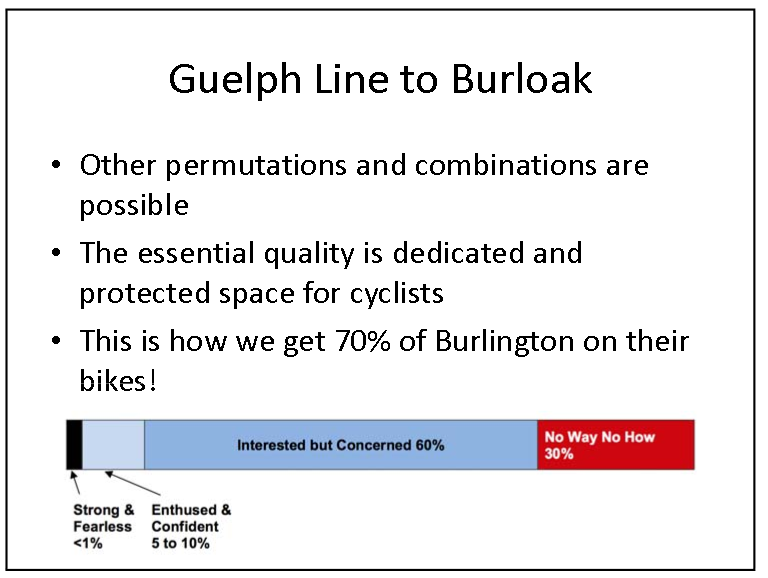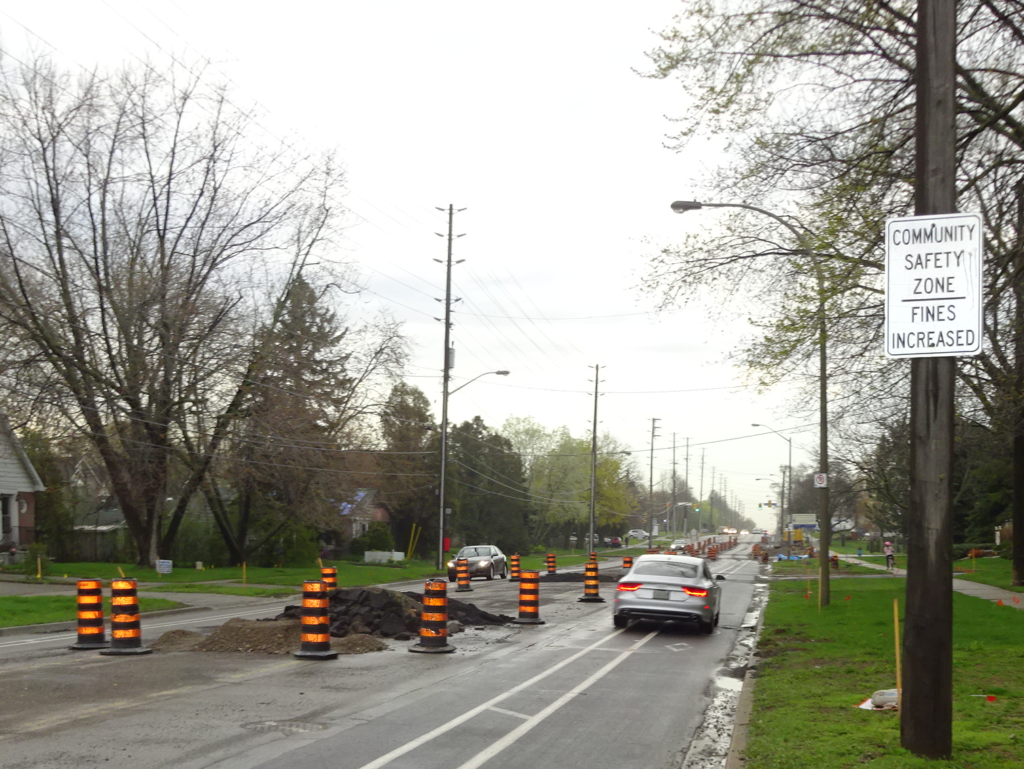May 29, 2017
BURLINGTON, ON
Revised 12:50 pm May 29th, 2017
Today is Bike to Work day.
Did Burlington celebrate the event?
They did – in an event at Civic Square but there wasn’t a line of bikes along New Street.
Not this year – that road is in the process of being rebuilt between Guelph Line and Appleby.
Where are things with the cycle lane for New Street?
Not much recent information on the city’s web site. The original plans to do a pilot exercise in 2016 didn’t work out all that well.
In his blog the Mayor said in 2016 that …
City Council supported a staff recommendation for a one-year pilot for bicycle lanes on New Street between Walker’s Line and Guelph Line.
A majority of council (6-1) supported this decision. It was our team of transportation experts that recommended what is being called a ‘road diet’. Simply put, that means taking New Street from four lanes to three lanes (two travel lanes and a centre left turn lane), with bike lanes separated by painted buffered lines on each side.
There are a few key things to note as we measure data and carefully listen to residents during the bicycle lane pilot project on the two-kilometre stretch of New Street:
This is a pilot project scheduled to last one year. Our staff will be tracking detailed data and we invite feedback from everyone using that stretch of the road.
The pilot is a litmus test to see if the painted lanes result in a positive experience for people who want to ride their bicycles, while causing a minimal impact for drivers who also need to get where they are going in a timely manner.
This is an ideal time for the pilot to be done as this section of road is scheduled for resurfacing in 2017. This means there will be no cost to revert the lanes if the pilot is determined to be unsuccessful by staff and ultimately, council, or keep the new lane configuration when the road is resurfaced.
I live by New Street and as such, take it every day, at different times. I will experience first-hand the traffic delays, if indeed there are any.
The key measurement for me will be the impact on the automobile driver. If there are significant traffic issues as a result of this new configuration, we can simply repaint the road. This one-year test allows us to see if New Street is the right place for bike lanes.
The multi-purpose pathway from Burloak Drive to Martha Street is good for recreational cycling. However, it is a busy mixed use pathway that includes not only cyclists but walkers, skateboarders, walkers with dogs and young children. A friend of mine broke his wrist after a young child darted in front of him causing him to slam on the brakes and fall. This means it is not ideal for people cycling along the pathway for transportation, especially when travelling at higher speeds.
The pathway is also not useable when it is dark as the average light from a bicycle is not bright enough and does not shine far enough to create a safe ride. The pathway is not lit at night. There are also numerous crossings where vehicles have the right-of-way.
Furthermore, the pathway does not provide meaningful connections to the many amenities right along New Street.
The cycling enthusiasts explain that bike lanes on New Street by themselves will not have much of an impact – a fully developed cycling master plan with bike lanes throughout the city are what is needed and that is going to take some time.

Data provided by the Cycling Advisory Committee in 2016. Not much, if anything has happened since then.
Changing public opinion on bike lanes would seem to be the biggest obstacle.
The idea had support from a limited number of people; it was then so poorly executed that what little support got pummeled badly – can it be revived?






















Jim:
1. This reference may be of interest
https://safety.fhwa.dot.gov/road_diets/info_guide/rdig.pdf
Or look up “road diet” on Wikipedia and have a look at some of the work referenced there. There is a good deal of research available.
2. New Street can be used 24 hours a day – both vehicular and bicycle lanes are available to use. That doesn’t mean that there’s going to be someone using the street at all hours. If a resident wants to cycle to their after school job or drive to their night shift, the facility is there for them to do so.
3. I don’t know every bicyclist in Burlington. Given that approximately 30 percent of Ontario residents bicycle at least occasionally, that could be a large number of people.
4. Average speed of 72 kph was provided by the city’s Transportation staff. I have no details on where on New St. or when that was measured.
5. The third lane is the centre turn lane, which enables left turns to be made without blocking a through lane. It’s an important part of the road and therefore I didn’t exclude it.
Not everything that comes from a different perspective than your own is “fake news”. And the best way to do anything is to imitate others who have demonstrated success. Cities like Seattle or NYC or Copenhagen or Madison or Vancouver or Calgary or Groningen all offer a good deal we can learn from. All of these cities are like us in that they are trying to encourage more cycling, and all have seen that protected infrastructure is the most effective way to do that. Some of those have different climate, or topography, or built forms. But in the process of making our city better and safer these examples are not at all irrelevant.
Chris Ariens
What cities are you referencing in your first paragraph? Are you back to Seattle and Vancouver again? Who are the bike riders that ride 24 hours a day? Do you have a list? Where did you get the “average speed was over 70 KM/h”? Please provide the time period and location you are referencing. The pilot was a reduction of two through lanes, not one, this is a fake news correction.
I’ve said this before and I’ll say it again. No bike lane is going to stop and impatient driver rushing to turn into a driveway or parking lot, cutting off a cyclist. Iv’e seen it many times.
The other side of that point is that impatient bike riders nearly cause accidents frequently, and I’ve seen – and experienced – that too many times. Putting them on the road next to cars is foolish.
No, a bike lane won’t stop all collisions. But they are proven to reduce the number greatly. It’s important to remember that whether cyclist or motorist, the person is a human being first. Humans make mistakes and sometimes do dumb things. When they do dumb things behind the wheel of a 20 pound bike they put their lives at risk. When they do dumb things behind the wheel of a 2 ton car they put everyone’s lives at risk.
On the good side, we all have instincts for self-preservation and not wanting to hurt others. When I’m a cyclist, being visible to cars keeps me alive. The way intersections are designed does not do a good job of ensuring I am visible on multi-use paths beside the road. Little things like moving stop lines back a couple of feet and bending the cycle track towards the road before intersections make it easier and many times safer for all of us.
What moderation would you like? If you want to remove the fake news in his name that is okay,
Jim
To Chris “fake news” Ariens
What cities are you referencing in your first paragraph? Are you back to Seattle and Vancouver again? Who are the bike riders that ride 24 hours a day? Do you have a list? Where did you get the “average speed was over 70km/h”? Please provide the time period you are referencing. The pilot was a reduction of two through lanes, not one, just another fake news correction.
Nice to have respectful dialogue with you, Jim. I am assuming that you are not 8 years old…do you really need to resort to name-calling to get your point across?
Chris, in my earlier post my take was protected bike lanes, absolutely, but it seems we are at odds at what a protected bike lane is. Paths that are completely segregated from cars is my position. Not a curb or some other form of protection as you suggest. The city of Toronto has announced the construction of more than 350m of barrier fencing along the Martin Goodman Trail after the death of a 5-year-old-boy when he fell off his bike onto Lakeshore Rd. Would this be a solution for New Street? If you want a sampling of what the impact is to other users, I again would suggest you read the many comments from the residents of Burlington on change.org whose daily commute has been negatively impacted by this pilot. 2335 voices strong and growing. This is just the petition. Add to this the many comments sent directly to our council members. Why drag this pilot out.
Eva…the Vancouver guideline document I posted above give a very good idea of how to make bicycle facilities safer for users of all ages and abilities (AAA). Notice that they state right out that “paint buffered bike lanes” such as what is on New St. today are not AAA. There are many ways of implementing protection, including metal barricades as Toronto implemented on the Martin Goodman trail. Some are more effective at keeping motor vehicles out than others. Some cost more than others. Some are a lot more aesthetically pleasing than others.
One concern I have with “total separation” is if motorists cannot see people on bicycles as they approach an intersection. There, the distance away from the road works against safety. I experience this on many of the city’s multi-use paths, where these are treated much the same as a sidewalk. A teenage boy was struck in one of these facilities in North Burlington last summer – by a hit and run driver.
I’ve read many of the petition comments, and I’m sensitive to the impact on drivers. But we also have to recognize that when we are behind the windshield of a car, our perceptions are distorted. Having to wait for a minute at a stop light behind other vehicles feels like forever. Moving at 40 or 50 km/h (a decent speed for rush hour in a major city) feels like a major imposition when you feel entitled to go 60.
So it stands to reason that we need real measured data in addition to public opinion to make an informed decision here.
40 years ago, I’m sure you could have got a similar turnout for a petition against making public places non-smoking when everyone smoked. It’s easy to be against something, but a lot harder to be for. Society changes over time.
We’re making decisions that affect the next generations of Burlingtonians – not just ourselves. Patience is hard to come by when you’re behind the wheel of a car and have to get somewhere in the moment, but it is critical we get this right.
Chris I too experience and witness many near misses with cyclists coming to an intersection or crossing the road from a multiuse path but this is not the fault of the car driver in many instances. I frequently drive on Longmoor and cannot count the number of cyclists I see not stopping before they cross the road from the path. Cars cannot drive on the paths and if cyclists stopped at the stop signs and crossed safely there would be no issue.
A little tongue in cheek comment about your smoking ban comment. I remember being asked if I wanted to sit in the non smoking section of the restaurant. Of course as it turned out, the smoke from the smoking section didn’t stop there. A little like painting a line on the road to separate 4000 lbs of steel from a bike.
Many of the comments on the petition are not just about having to wait a minute or more but how unsafe drivers feel, especially being cut off by the impatient driver from the short merge lane. Putting up neon signs here will not change this behaviour.
Protected bike lanes absolutely but not what we have on New Street now or on so many of our arterial roads. Time to stop the New Street Diet, go back to the drawing board and get serious about a network of protected bike lanes. Another news report of a woman in her 20’s struck by a vehicle yesterday afternoon in a bike lane in Scarboro. She has life threatening injuries. I don’t want to start reading reports like these in Burlington.
Agreed.
Important to remember it is a pilot project. The main benefit is to learn what the impact is to other users. Curbs or other forms of protection can be added in the buffer space. I recommended that this be done during the pilot and will continue to recommend that this be done after.
If that impact is not manageable, we’ll definitely have to consider other alternatives. A network of protected bike lanes will take time, but it will be that much more difficult to do without something on New Street, which is undergoing a very costly reconstruction. It’s not ideal, but right now is the best time to address it as we won’t have the chance again for over 30 years.
I don’t want to read these kind of reports either. That’s why I’m supporting protected bike lanes. The benefits to public safety is more than worth it.
If you really think it’s a “pilot” project, you’re living in Fantasyland – but then most, of your posts don’t seem very connected to reality. The number of commuters that flood into and out of Burlington daily for work requires all of the available road space. There is no slack capacity during rush hours. New Street capacity is not available for bicycle traffic, and no sane person would want to ride alongside cars anyway. It’s a non-starter – give it up.
I question the statement “there is no slack capacity during rush hours”. The pilot project (and yes, it is a pilot project) will give us data that answers this question. Other cities with similar traffic levels have had traffic flow effectively with 3 lanes devoted to cars, so it stands to reason that Burlington can also make it work.
And if it doesn’t, the question still remains…what is the benefit from making it easier for people to drive their cars 2 hours a day and in the process make it more difficult for those who want to ride their bikes 24 hours a day? The average speed was over 70 km/h, which is clearly not a safe condition for an urban street with schools, community centres and seniors’ residences all along its length. Originally the city wanted to put sharrow markings on the south side (that will surely make it safe).
People flooding into and out of Burlington for work can use any of the east west roads or the QEW, they don’t need to use New Street. This is the bigger issue which causes much of the aggravation for commuters. When there is congestion on the QEW in the PM rush, people feel entitled to use our local streets as thoroughfares. That 1 lane makes little difference – the system is bottlenecked everywhere regardless.
Chris. Your “evidence” is easy to nitpick since most of it is irrelevant to the conditions in Burlington We have winter conditions for at least five month of the year and bikes don’t seem to be set up to carry hockey equipment including sticks.
Jim…now your nitpicking is bordering on irrational.
Even in winter, the conditions are quite often fine for biking. It gets cold, you wear a coat and gloves, just like anyone who goes outside. We are Canadians, aren’t we supposed to enjoy being outdoors in the winter? The roads in Burlington were completely dry nearly half the time this winter. Protected bike lanes separated from cars would certainly be used in the winter – especially if plowed. Maybe a fraction of the use they would see in the summer but still quite doable.
Plus, not everybody needs to carry around hockey equipment for every trip they take. But if you need to do so, yes, there are ways. A simple Google search found lots of tips on how to do it.
Can you show some solid evidence that is contrary to the evidence that I provided? I’ve studied this issue for years and have yet to come across any so please enlighten me.
Chris, I am insinuating nothing. I am suggesting that you learn scientific methods to move an hypothesis to a conclusion and then implement what you have learned. I hope this is not to much to ask. The English language also gave the quote ” doing the dame thing over and aver again expecting a different result is insanity”
Jim, I’m more than eager to test the hypothesis that protected bike lanes will lead to much higher rates of cycling, improved safety (and a whole host of other economic, environmental and social benefits for my hometown).
You on the other hand seem to want to nitpick and invalidate every piece of evidence as being irrelevant to our own situation.
Absolutely right though about doing the same thing over and over again. Spending time trying to convince people to let go of their preconceived notions about cycling is rather futile, but I do it anyway.
I’m sure Mr. Ariens will disagree, but clearly walking along the side of a road (like New St., or Upper Middle Road) in the “bike path” is suicidal, which is why we have sidewalks for pedestrians.
I have to wonder about anyone who thinks that riding unprotected in that same space on a two wheeler is somehow safer than walking in that space. Road side bike paths are stupid, period.
Hans, I don’t disagree with you at all. Most people do not feel safe separated from car traffic only by paint. That’s the point I’ve been consistently making all along. A bike lane is obviously safer than no bike lane, but as I stated above, the way we’ve been building bike lanes here in Burlington is not working for most of us.
What I disagree with is the comment that “the negligible demand will never justify them.” The negilgible demand is because people don’t want to risk their lives in close proximity to fast moving cars. That’s the same line of thinking which Stephen White pointed out in his message as well. Common sense!
Provide protected bike infrastructure and many more people will ride. And the more people ride, the safer it gets. It isn’t rocket science, it doesn’t make a difference what kind of weather there is, and it is supported by data from every city on this planet which has done it.
I love how everybody who I engage in discussion of this issue is so eager to share their preconceived notions of me, rather than actually discussing the facts.
Chris is at it again! Comparing us to Vancouver and Seattle ignoring the completely different weather patterns between us and the cities on the Pacific. He could start by comparing snow removal budgets per capita. He will likely go back to comparing us to the Netherlands next.
Jim…did I compare Burlington with Seattle? No. I held out Seattle as an example of how the chicken and egg problem which Hans alluded to has resolved itself.
What the data shows is that Seattle businesses near protected bike lanes have considerably more cycling than Seattle businesses not near protected bike lanes.
Clearly, Burlington is nothing like any place else in the world, a unique snowflake in which things that work elsewhere in the world never apply, and we in Burlington have absolutely nothing to learn from others who have proven capable of changing the way they do things. Basically what you’re insinuating is that we’re all incapable.
The 8 most unhelpful words in the English language: “We can’t possibly do that in our city.”
Please read the comments on the petition at change.org which now has 2334 supporters opposing the New Street road diet. Many cyclists say they will never use the bike lanes on New Street because they do not feel safe. Toronto is reviewing the safety of their bike lanes in view of the recent tragic accident where a 5 year old boy was killed falling from his bike into traffic. I hope Burlington Council is taking note.
The New Street Road Diet is at best the biggest failure in city history since the Pier disaster.
No politician will hook their wagon headed to an election to this failure.
Funny how the Mayor and other councilors have changed their tune on this fiasco.
A lot of taxpayer dollars has been spent on painting bicycle line on New Street. Today we traveled by car on New Street from Appleby to Guelph line. We observed approximately 100+ cars and vehicle and two bicycles. The first bicycle was driving east on the north sidewalk and the second was driving east on the south bicycle lane. That’s a lot of taxpayer dollars spent to accommodate minimum bicycle traffic spent on bicycles that do not pay a cent in taxes.
There are wide boulevards on New Street why not pave a bicycle path on the boulevard. (Then paint bicycle lanes on the street like those on Upper Middle to spend more tax payer dollars foolishly). I am amazed at the wasted dollars this city council spends needlessly e.g. the lawsuit regarding the pier, the lawsuit regarding the Burlington Airport landfill, etc. Lets hope the taxpayer remembers this waste at our next election.
Cyclists (or their parents) don’t pay a cent in taxes now? Great, where can I sign up?!!
The New St. on-road painted line pilot that is currently in effect was budgeted at around $210,000 (plus another $732,000 to complete it to Burloak, if considered successful). The paved bicycle path option on the boulevard (cycle tracks) that was also given due consideration was estimated at around $5 million from Guelph to Burloak. Are you complaining that they should have spent $5 million instead? Council and Staff are trying the cost-effective option.
In Toronto recently, a 5 year old cyclist fell off his bike into traffic and was killed. The New Street bike lanes create exactly that kind of risk. Does anyone expect children to ride in those lanes?
I would prefer to spend the 5 million to avoid that, if we MUST have New Street bike lanes. But the reality is that we don’t need New Street bike lanes, since there are adequate alternatives and the negligible demand will never justify them.
If it were my child there would be no way in hell that I would ever allow him/her to be riding a bicycle beside a busy road like Lakeshore Road in Toronto. No five year old I know is mature enough, or aware enough, or sufficiently experienced enough, to handle a bicycle with sufficient precision to avoid an accident. This tragedy was totally preventable.
Riding a bicycle on a quiet, residential street is a far cry from riding a bike on a major arterial or busy street like Appleby, Walkers, Guelph Lines or New Street. Sadly, that is a realization that most bike advocates don’t grasp. I have ridden a bike for years but there is no way you would ever get me on a major street despite what the Mayor and the cycling advocates promote. Sadly, common sense, reasonableness and public safety obviously don’t weigh heavily in this discussion.
We definitely need to give a lot more thought to making things safe for people of all ages and abilities.
Vancouver has put out some guidelines that are extremely helpful…
https://vancouver.ca/files/cov/design-guidelines-for-all-ages-and-abilities-cycling-routes.pdf
The bike lanes we’ve built in the past on the arterial roads are clearly not working for the majority – the ‘interested and concerned’ in the chart above. And unfortunately most destinations in the city require people to use these kinds of roads to get there – there simply is no other way.
How do we connect these destinations – malls & shopping areas, transit stations, parks, and neighbourhoods to make it safe enough for you? For kids to be able to bike to school or to the park, for young adults to get to their part-time jobs and activities, for seniors to do some of their day to day errands on the bike just as easily as they can in their car?
The classic ‘chicken and egg’ scenario.
https://www.cbc.ca/news/canada/toronto/toronto-bike-lane-building-1.4136775
More data on the chicken and egg – this one from Seattle.
https://www.seattletimes.com/seattle-news/transportation/would-more-protected-bike-lanes-in-seattle-encourage-more-bike-commuting/
There has been a perfectly good multi-use path running from Martha to Burloak that’s been in place for over thirty years. Cost? Basically $0
“Today is Bike to Work day. Did Burlington celebrate the event?”
Yes. https://burlingtondowntown.ca/events/bike-to-work-day/
Burlington celebrates “Drive Your Car to Work Every Day”. For most people, that’s the only solution that works.
I live on a busy road, and I’m sure I saw a couple of bikes this morning.
I would like to see a “Learn How to Ride Your Bike Safely” day instead. Too many bike riders apparently think that the Rules of the Road don’t apply to them, or perhaps are ignorant of the Rules.
Any cycling infrastructure must separate cyclists from other traffic by more than some paint on the road.